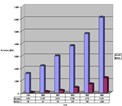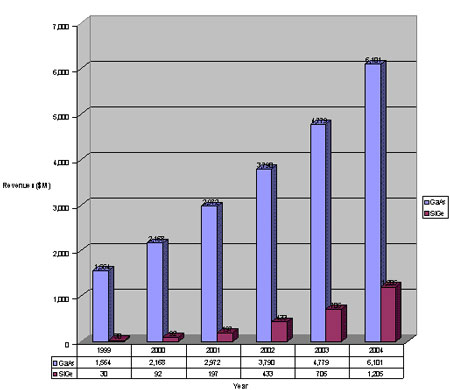The SiGe IC market

The combination of high-bandwidth, high-gain and low-noise SiGe HBTs (heterojunction bipolar transistor) with dense CMOS functionality in a SiGe BiCMOS technology enables powerful single-chip transceiver architectures for multi-GHz and multi-Gb/s communication applications. SiGe BiCMOS technology has moved from a laboratory research effort to a mature production technology. Devices improve performance and reduce power consumption for wireless applications, including the convergence of voice, data, video, and location functionality within mobile phones; as well as cordless, short distance wireless, global positioning systems, wireless meters, and other emerging systems.
Contents
• Technology
• Applications
• Competition
• Market
IBM first reported a SiGe HBT device in 1987 and in 1990 demonstrated a SiGe HBT having a 75 GHz cutoff frequency. In 1992, a full BiCMOS technology combined high performance SiGe HBTs (18 psec ECL gate delay) with 0.25 µm CMOS devices. IBM took SiGe technology into volume manufacturing in 1996. By scaling the HBT structure in both lateral and vertical directions, IBM designers reached 90 GHz. IBM's researchers have integrated scaled SiGe HBTs with the company's 0.18-µm, 1.8/3.3-V copper metallization CMOS process, with little effect on CMOS device properties and design rules.
Return to Table of Contents
Technology
SiGe HBT relies on bandgap engineering for its extraordinary performance. From 10% to 20% Ge content in the transistor base enhances the speed, gain and noise properties. There is a 4% difference in the lattice constants of Si and Ge. The resulting strain may be used to vary the bandgap and numerous other properties of the material.
The smaller bandgap of SiGe compared to Si enhances electron injection, producing a higher current gain for the same doping level compared to a Si device. Thus, the base can be doped more heavily in the SiGe HBT in order to lower the total base resistance. Germanium introduced into the base layer of a slicon bipolar transistor significantly improves operating frequency, current, noise, and power capabilities.
Return to Table of Contents
Applications
Currently announced SiGe products cover a wide range, with 10-Gbps SONET, 12.5 Gbps Ethernet, cellular base station and handset components, optical transmit/receiver systems, wireless LAN, and digital network switching. In addition to matching worldwide specifications for current cellular protocols and new standards for third generation cellular (3G) products, SiGe promises to be a major factor in the emerging Bluetooth and IEEE 802.11 standards for home wireless products. Other SiGe applications include Ka-Band CPW oscillator HBTs, a 77 GHz near-field sensor with SiGe Schottky diodes, and a 77 GHz closing velocity sensor.
A large number of research labs and chipmaker fabs are working on material growth methods and properties, circuit design, and device fabrication and characterization, with commercial products emerging. New epitaxial structures produced by high vacuum CVD techniques are gradually finding their way into increasingly complex electronic circuitry.
IBM's SiGe manufacturing services have been contracted to deliver chips for Alcatel, AMCC, DSP Communications, Hughes Electronics, Intersil, Nortel, Qualcomm, RF Micro Devices, and Tektronix in the communications, storage, and test and instrumentation arenas. IBM is also codeveloping SiGe chips with Siemens, RF Micro Devices, and Philsar Electronics (recently acquired by Conexant Systems).
OC-192
Leading long-distance carriers and telcos are suddenly investing heavily in next-generation OC-192 equipment and, in the process, lighting a fire under the 10-Gbit/s IC market. The catalyst is skyrocketing Internet traffic and a surge in demand for e-commerce, audio/video, and other new services. SiGe proponents argue that the technology can greatly reduce cost and power consumption, compared with GaAs alternatives, while supporting higher levels of functional integration.
In 1998, Alcatel (Paris) announced the commercial availability of its newest OC-192 (10-Gbit/second) Sonet system, an optical-fiber transmission system based upon the earliest generation of SiGe technology. Infineon Technologies AG has also opted for a SiGe process for its latest OC-192/ STM-64 Sonet/SDH chipset.
Among other vendors, Lucent Technologies Inc.'s Microelectronics group has optimized a four-layer SiGe process for Sonet line-rate OC-192 applications that allows designers to combine memory blocks, DSP cores, and other traditional CMOS-based intellectual-property cores with high-speed SiGe interfaces for optical wireline and wireless applications.
Not all companies are opting for a SiGe solution. GaAs supplier Vitesse Semiconductor introduced a 10 Gbps multiplexer/demultiplexer (1:16) chipset using its proprietary H-GaAs-V process. Another GaAs supplier, Anadigics, opted for InGaP, citing benefits that include very high reliability, resistance to temperature influences, and excellent performance uniformity
OC-768
The next step after OC-192 is OC-768, which delivers an incredible 40 Gbps per channel. Even though OC-768 hasn't hit the market yet, it is still important because a new set of technologies, both optical and electrical, are required to achieve this speed. The most important challenge to building SONET at OC-768 and beyond is likely to come from the electronics-the faster the chips, the harder they are to make. OC-192 chips already present challenges. OC-768 presents even more.
IBM has quietly married its copper interconnect process with a new 0.18-µm SiGe technology to produce communications ICs capable of handling up to 40 Gbps transmission rates. Others, such as Lucent and Infineon, are looking to SiGe or some specialized derivative or compound processes for next-generation solutions.
Vitesse expects to use InP for transimpedance amplifiers, postamplifiers, laser drivers, multiplexer /demultiplexer parts, clock multiplier units and clock-and-data recovery circuits. Indium phosphide has a transistor cutoff frequency of 160 GHz, compared with 90 GHz for SiGe and even less for AlGaAs. The cutoff frequency should ideally be three times the operating frequency. InP also has a lower threshold voltage, making 3.3-volt systems easier to design.
Bluetooth
Bluetooth technology answers the need for short-range wireless connectivity in three areas: Data and Voice access points, Cable replacement, and Ad hoc networking. Its specification defines a system solution with hardware, software and interoperability requirements. The Bluetooth radio operates in a globally available 2.4 GHz ISM band, ensuring communication compatibility worldwide. Still in development, Bluetooth allows cell phones, notebook PCs, and other handheld products to transport data over a 1-Mbit/s wireless network.
In early 2000, Philsar (Ottawa, ON) entered the Bluetooth market with a single-chip transceiver. The company's PH2401 works in conjunction with a baseband controller to support wireless connections via 2.4-GHz spread-spectrum technology. Philsar's chips are based on a SiGe process licensed from IBM Microelectronics. IBM's BiCMOS6HP combines a high-performance bipolar transistor with a quarter-micron CMOS technology, bringing the RF IC and high-density digital content together on the same chip.
Return to Table of Contents
Competition
Companies can shift from silicon-only to a SiGe HBT without adding significant processing costs. SiGe provides performance comparable to gallium arsenide or other more exotic, expensive materials, and can be processed in a silicon fab. Silicon-bipolar transistors can achieve switching speeds of 15 to 20 GHz, whereas SiGe transistors can achieve speeds of 50 GHz.
Return to Table of Contents
Market
Low cost, high performance Si/SiGe IC's are ideally suited for the high volume markets. Mobile communications transmit audio and voice via handy phones at 0.9 to 2 GHz. The wireless local area networks (WLAN) at 2.4 and 5.8 GHz connect PCs. Satellite communication at 10–14 GHz, 25 GHz, or even higher supply low infrastructure areas and mobile users. Wideband communication via coax and fiber optic cables transmit from 3 to 40 Gbit/s mainly in urban hubs and in intercontinental networks. Each of these services will have 50 to 100 million users or terminals by the year 2005.

In addition, we see markets in navigation of mobile objects, e.g. global positioning (GPS ~1.5 GHz), satellite navigation (>10 GHz), defense and landing radar (20–40GHz), collision avoidance of cars (~70 GHz), and robotic and industry sensors (20–50GHz). Computer and consumer electronics which demand faster signal processing might be a market for a SiGe chip. The share of microelectronic components in these systems is 20% to 40%, which makes this market attractive for chip manufacturers.
The GaAs market, the main competitor of SiGe, will grow at a compound annual growth rate (CAGR) of 31.3% between 1999 and 2004, reaching values of $6.1 billion. The SiGe market will exhibit a CAGR of 109.3, reaching levels of $1.2 billion in 2004.
The Business Roundtable column allows prominent industry analysts and observers to comment on trends in the integrated circuit and semiconductor manufacturing markets. Readers can pose questions and suggest topics for future columns in a companion Discussion Forum, or by sending e-mail to the Editor. Firms and individuals interested in contributing to the Roundtable should also contact the editor.
